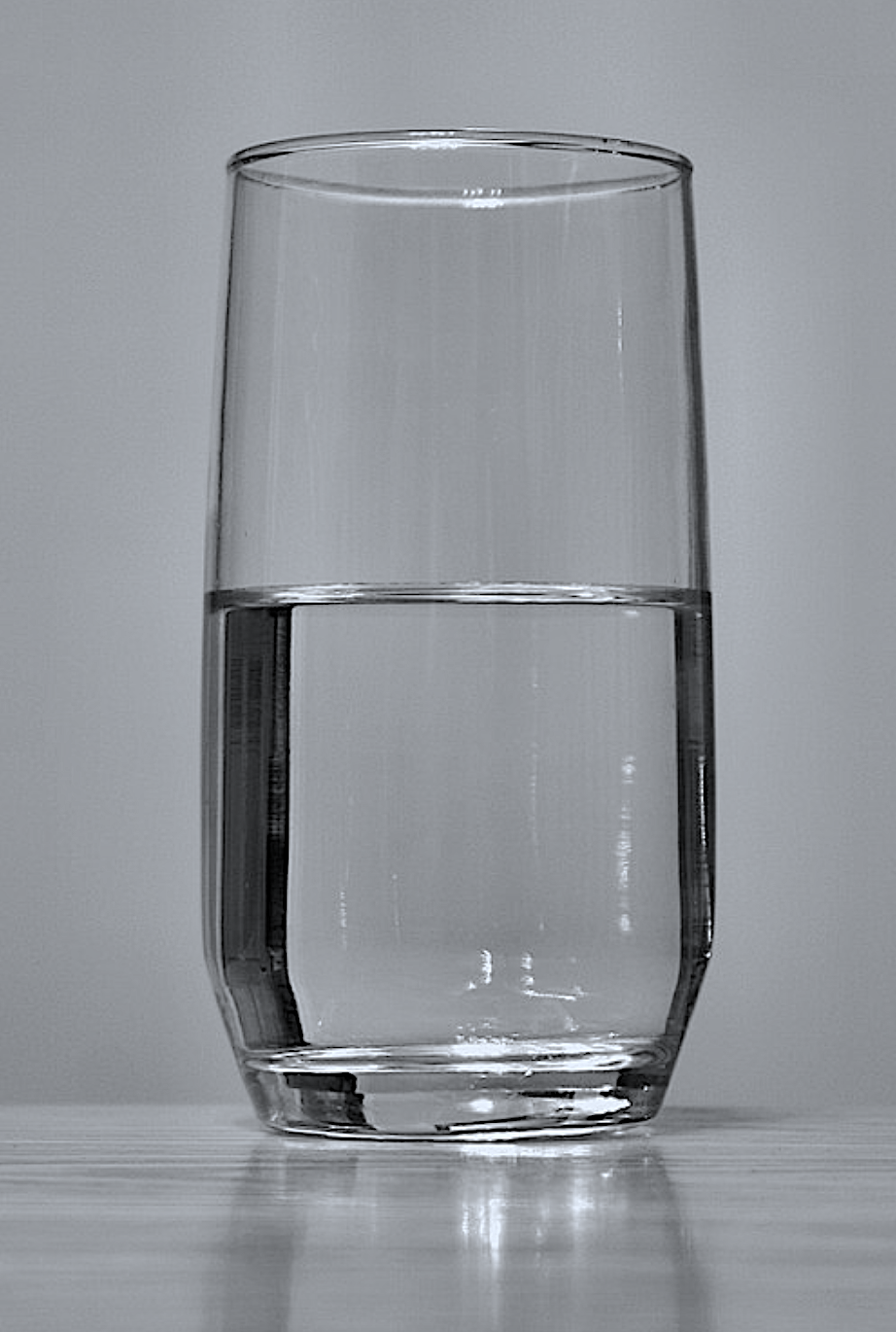There are things we can choose to see either way.
Some flip back and forth as easily as a half-full or half-empty glass of water. Set aside the half-full/half-empty association of positivity or negativity and just take it literally—look at the glass of water.
Allow your mind to focus on the half-full side, then the half-empty side. In the case of the picture above, it really actually is both a half-full and half-empty glass of water—at exactly the same time.
Since both perspectives are undeniably true, it is easy for your brain to switch back and forth, without doing anything but flipping a switch. Feel it? Toggle that switch a little faster now: half-full, half-empty, half-full, half-empty.
Okay, so now you understand the power of perspective. Your brain can, at will, view something as being one way or another, and you can decide which view to adopt and when.
There are many, many life situations we may find ourselves in where it is not so clear, where it’s hard to see that multiple perspectives can be true at once. These situations can cause pain, confusion, self-doubt, relationship turmoil, and sleepless nights.
Understanding our ability to flip from one perspective to the other—just like we can with that half-full glass of water—is the hidden superpower that we all have at the ready.
But knowing when and how to choose which perspective to adopt is not up to anyone but you.
Here are a few examples of when different perspectives can both be true at once:
Obligation versus Commitment
People often say, “Love is something you have to choose every day.” Relationships are beautiful and rewarding, but they take work. The work part of any relationship is ever-present; it is about staying connected to the person you first met. It is about keeping your eye on the prize and choosing to value the bond and the family, if kids are in the mix. It is about not letting petty, small stuff get in the way.
Sometimes, though, the work part seems too big; it is around this point that we might start to experience some confusion, the point we try to figure out whether the issues we have are normal, expected aspects of a committed relationship or whether they are tipping over into something less healthy, with more obligation than commitment in the mix.
The exact same circumstances can warrant either label.
Commitment isn’t easy—it will have moments that feel like obligation. But obligation is not sustainable, and it can masquerade as being part of commitment. Relationships often need a purposeful adoption of a commitment perspective to give them a fighting chance. Yet, sometimes, people in relationships need a dose of an obligation perspective to see when things are not okay.
So, you toggle between the two, questioning, testing, asking:
>> How hard should commitment be?
>> Are my expectations set at the right place for me?
>> Where are my priorities?
>> Am I doing things I want to be doing?
>> Am I just too selfish?
Consider such questions through the perspective of obligation and through the perspective of commitment to help you figure out where you stand and whether one perspective might be more true for you than the other, or whether they are both true, as in the case of the half-full, half-empty glass of water.
Tolerant versus Over-Compromising
Your partner stays out with their friends. They don’t do household stuff. They load the dishwasher in annoying ways. They smoke weed in the house. They pass out on the couch with a bottle of wine. They watch too much TV. The bathroom is disgusting. How do you deal?
You want to be tolerant. You want to offer them the same freedom you hope to enjoy in your house and your life; but how far is too far?
Should you tolerate only the things that are really, actually, okay with you? What about the stupid stuff that is not okay with you that you just prefer not to deal with, like how they load the dishwasher? Of course, you should tolerate or compromise on stuff like that, right?
But what about the more important stuff like reliability or substance abuse or how they treat your kids? Should you offer the freedom that you hope for, even when you know isn’t really okay with you?
How do you find that perfect line?
Toggle between perspectives, asking yourself whether the line you have settled on is being a supportive partner or whether it is giving in too much. Both can be true at once. One can eat away at you and one can eat away at your relationship. What “half of the glass” serves you best? What perspective will serve your relationship? Short-term? Long-term?
Healthy Boundaries versus Protective Delusions
Speaking of healthy boundaries, how do you even know what is healthy? How do you know whether your boundaries are healthy or whether they are armored, self-protective delusions?
Here is a small example: other than slow dancing, I don’t really like to dance with people. At live music events, I like to dance with the music and don’t like to dance with a person, even my husband or friends I have gone to the show with. Maybe I attended too many Grateful Dead concerts as my live music context, but I get mucked up when I have to pay attention to a person and not the music, it makes me uncomfortable, and it is distracting.
Then, I come across articles on childhood trauma or distant parents. I can check off the boxes and tell myself a story one way or another that how I feel about dancing to live music means this or that for my life and get into a minor swirl. Does that mean I have intimacy issues that I need to fix or is that just a boundary that works for me? Or is it just a preference that means absolutely nothing? Exhausting.
Leaving behind the live music example (thankfully), I toggle on the bigger question applying one perspective, then the other: are my boundaries healthy and rooted in self-actualization or are they protective rationalizations I have created to allow me to avoid intimacy?
Truth be told, I am a rookie in the setting-healthy-boundaries department, so I spend quite a bit of time messing around with this toggle. Both may be true at once, my boundaries may be healthy and protective at the same time. In fact, both probably are true at once, and perhaps that is the point of boundaries in the first place.
But I am now old enough to be almost out of f*cks to give on what I should or shouldn’t do in this life, so, if both are true, really true, as I suspect they are, then I can simply decide to choose the perspective that fosters the most joy, gratitude, and peace.
Happiness or Cop-Out?
What if at the end of the day, you land in a life that feels pretty good? Where you seem to be having positive and improving the relationships in your life, and where you are tapping into your creativity pretty often, and where you have found meaningful work where your contributions seem valued? Where you feel pretty at peace, and your internal voice is mostly kind to yourself, and your self-doubt has evolved into what feels like mostly healthy questioning?
How does that sit in the world today, with its never-ending parade of all the ways we are flawed? All the shortcomings we are constantly prompted to identify and name and trace back.
That environment, even among the more progressive spiritual communities, puts a pall over peace and happiness. If you start to suspect you have landed there, you can’t help but be skeptical: could I really be at peace? If I am feeling pretty peaceful and happy, what about all my unresolved traumas that the world points out? Can one be sure that even a happiness rich with gratitude and joy is real? How do I know I am not deluding myself? If I think life is good, is that a sure sign that it is not?
Can I qualify as “happy” if I am not practicing gratitude every single day? Not exercising enough? Still eating meat? Still drinking? Still watching bad TV? Not eating organic and not doing yoga? If I am feeling at peace but not doing all those things, can it be real?
Where is the line between numbed existence and genuine, valid peace?
With every passing year, I get better at listening to myself and sorting out the bullsh*t rationalizations from the truth, and if nothing else, 2020 has been good for that. We all have had unhelpful messages we hear from our internal voice that we must learn to set aside.
We have undercurrents in our minds telling us that we are worthy, that what we think and perceive and believe matters, that we really do know the difference between our truths and the externally-driven, socially-pressured crap that is clogging the airwaves and should be ignored.
My big awakening is realizing that, like a half-full and half-empty glass of water, different perspectives about myself, my life, and my worth, can both be true at once.
This means we can have a choice between truths instead of the agonizing task of determining one truth. The power of perspective means that more than one thing can be true at once, and this doesn’t just apply to our opinions versus another’s opinion; it applies to our own thoughts about ourselves.
That seems worth repeating: the power of perspective means that more than one thing can be true at once, and this doesn’t just apply to our opinions versus another’s opinion; it applies to our own thoughts about ourselves.
So, I continue to toggle between the idea that I am living a steady, peaceful, enjoyable existence and the worry that I am merely fooling myself.
Lately, I find I am tiring of this worry, but like the half-empty side of the glass of water, it is always there and its constant presence is actually good—it keeps giving me the chance, every day, to choose the truth that works for me without losing sight of the one that doesn’t.
 Share on bsky
Share on bsky






Read 1 comment and reply